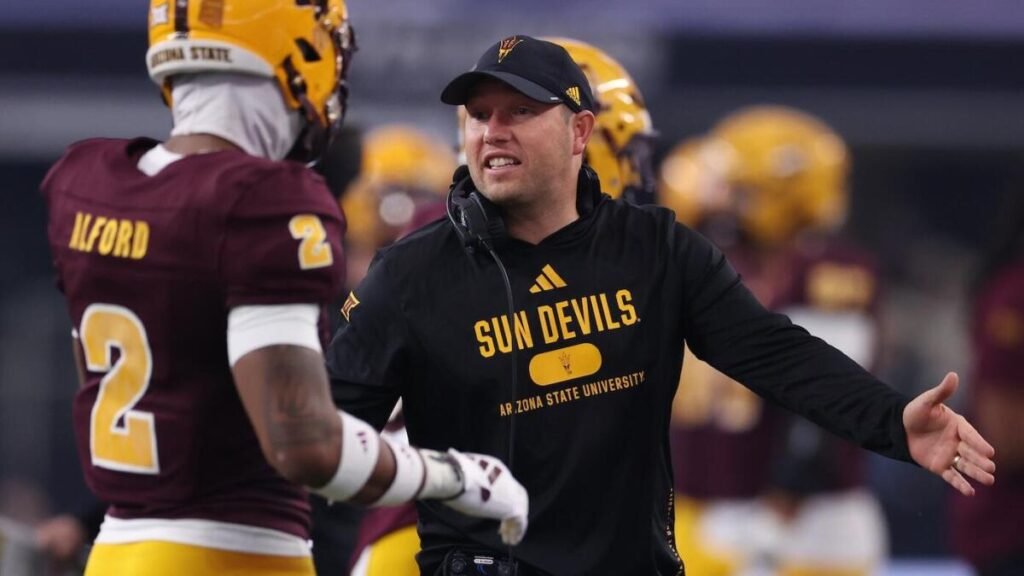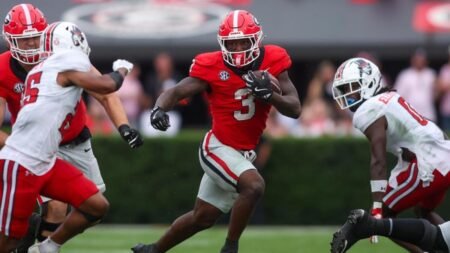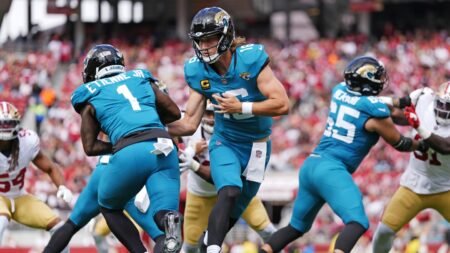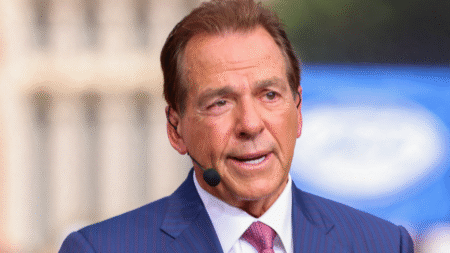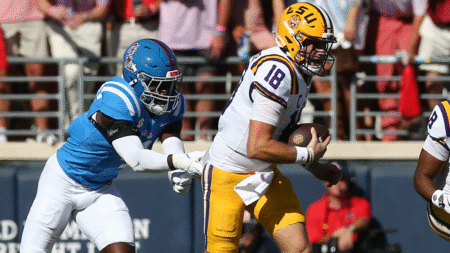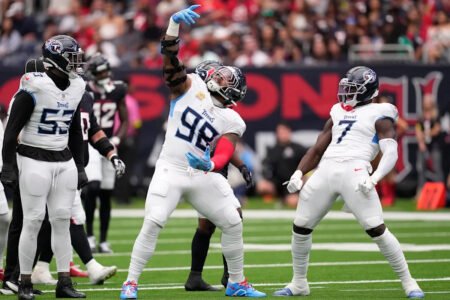SAN ANTONIO — When Kenny Dillingham took over at Arizona State at 33, he knew he had to establish recruiting pipelines. The wunderkind flew up the ranks after rising with Mike Norvell from ASU to Florida State, and learning under the wing of Gus Malzahn and Dan Lanning.
With an invitation to the Big 12 on the way, the state of Texas became an obvious — and necessary — home.
“The Big 12 to me is an extension of Texas high school football,” ASU cornerbacks coach Bryan Carrington told CBS Sports. “A lot of guys who go Division I played each other in the playoffs, played each other for state championships. So it’s like, hey Dilly, either we make Texas a priority or we’re going to lose to teams that made Texas a priority.”
Carrington started his career as a student recruiting assistant under Tom Herman at Houston, helping to launch a dynamic recruiting effort in the city. After initially teaming up with Ra’Shaad Samples — son of Texas high school coach Reginald Samples — at TCU, the pair later reunited at Arizona State. There, they worked with other Texas-tied staff members and Dillingham to launch the “Texas to Tempe” pipeline.
Meet college football’s kingmakers: 22 front-office executives who are revolutionizing how rosters are built
John Talty
“We kind of like to say, Arizona’s like a baby between L.A. and Texas,” Dillingham told CBS Sports. “If they had a child, that’s Tempe. It’s a really good mix for kids from the L.A. region who want to get more southern, or a kid from the Texas region who wants to get more western.”
There were five Texans on the roster when Dillingham got there, headlined by tight end Jalin Conyers. On the Big 12 title team, there were more than 20 players from Texas, including three All-Big 12 selections. Seven more are on the way in the 2025 class. Eight are already committed in the Class of 2026.
Arizona State marked only the most recent entrant into the battle for Texas, which has only been electrified by conference expansion. Three of the four power conferences now boast schools in the state. Four additional conferences either have teams now, or will soon. The Big Ten and MAC are the only leagues without a Texas footprint, and powerhouses like USC, Oregon and Ohio State still hit the state extremely hard.
And with the talent coming out of the state, it’s little surprise. Last year, 55 Texas players finished rated as blue-chips by 247Sports. Thirty-five were listed in the Top247. Including 2026, Texas produced either the No. 1 or 2 quarterback in each recruiting class for five of the past six years. The one exception was 2023, when Arch Manning went to Texas.
So despite a dramatically changed recruiting landscape, the allure of the “Texas tied” coach still lives on.
Nationalized scene
For most of its existence, the Southwest Conference dominated Texas recruiting. Oklahoma and Arkansas built pipelines in the state, but the vast majority of players opted to stay and play for the local schools. National championship teams at Texas were built almost exclusively on the backs of in-state recruits.
However, the entrance of Texas A&M to the SEC in 2012 opened the floodgates to a truly nationalized recruiting scene. And with it, having assistant coaches with Texas ties has been a life source for programs around the country.
“I know a lot of coaches want to get up here and sing the blues to you and say everything’s just transactional,” Texas coach Steve Sarkisian said. “I just don’t believe that.”
Samples is now the assistant head coach at Oregon. Oklahoma receivers coach Emmett Jones is a former high school coach at South Oak Cliff in Dallas. Kansas State assistant head coach Van Malone played at Texas and was a former Texas high school assistant. Notre Dame director of player personnel Jourdan Blake played at Baylor and worked at SMU and TCU before landing in South Bend.
Countless other coaches have deep relationships in Texas, either from coaching there or recruiting the area for years. LSU’s Frank Wilson was the coach at UTSA. Michigan secondary coach LaMar Morgan is a native Texan. Ole Miss general manager Billy Glasscock arrived after multiple years at Texas. No coincidence, each of these programs have major recruiting wins in Texas in 2025.
“It’s really big when guys [we recognize] step into our offices,” North Crowley High School coach Ray Gates said. “We know who they are, we have relationships with them and there’s a lot of trust that goes along with that… credibility is everything.”
Perhaps the greatest growth has actually been among programs in the state of Texas. Former Baylor coach Matt Rhule set the blueprint in many ways, adding three active high school coaches to his staff when he took the job and instantly integrating himself into Texas. Since then, nearly every program in the state has followed suit, even those like UTSA (Jeff Traylor) and Texas Tech (Joey McGuire) who are led by former Texas high school coaches.
In that mold, Texas A&M coach Mike Elko hired DJ Mann, a former high school coach in Lubbock, to lead his outreach efforts. Texas has Chris Gilbert, who coached in DFW. Baylor (Kaeron Johnson), TCU (Bob Wager), Texas Tech (Kenny Perry), SMU (Scott Nady) and Houston (Shawn Bell) also all have former Texas high school football coaches on staff.
“Who is the guy making sure high school coaches know when we’re practicing? Who’s the guy that knows how high school coaches can get tickets? Who is the guy that can be the contact point when high school coaches come on campus?” Elko said. “There are a lot of head coaches in the state. It’s just a way for me to have someone to help bridge the gap.”
The aforementioned Rhule, by the way, hired Susan Elza as his chief of staff at Nebraska. Elza was the director of athletics for the UIL, the organization that administers high school football in Texas. It doesn’t get more Texas-tied than that.
“It’s easier for Texas schools to build a relationship with Texas players,” Arizona State running back commit Cardae Mack said. “But if out of state schools are really willing to get what they want, they’ll build that relationship even better.”
How ties pay off
Former Texas A&M coach Jimbo Fisher needed only days to commit his first faux paus after signing a 10-year contract with the Aggies in 2017. Instead of paying fealty to the Texas High School Coaches Association like most others, one of Fisher’s first visits was to a private 7-on-7 coach, which drew the ire of high school coaches.
“It was just a matter of not knowing the climate and how we’ve been working hard to keep that element out of Texas,” THSCA executive director D.W. Rutledge told the Dallas Morning News at the time.
While Fisher ultimately was able to recruit at an elite level despite the error, his tenure helped show some of the ways that damaged relationships can backfire. Out of 30 members of his historic 2022 recruiting class, 22 eventually transferred. Three years later, only three players were drafted from Texas A&M. Many have already flamed out of multiple schools. For comparison, 12 players were drafted from rival Texas, including three brought in as part of the Longhorns’ 2022 haul, despite a “lower-ranked” class.
“If it was all just about money, then yeah, I might sign a decent class,” Sarkisian said. “But they’re not made of the right stuff. What I’m looking for might be better somewhere else.”
Texas high school coaches believe that they can help be the difference. Coaches talk, and have opinions on what kids might have the makeup to handle the rigor of college football. Or they might see those who may test well, but never challenged them on the football field.
Close relationships with high school coaches can also ensure that you get eyes on promising young players first, and even give out initial offers. Getting there early, especially as an out-of-state coach, can make all the difference.
“The difference between the No. 250-ranked kid and the No. 1,000-ranked kid, it’s not a big difference,” Dillingham said. “This isn’t the NFL where they have data points for days on all of the players that are going to enter the league. The difference between these guys is so small that the relationships that you have in those cities can give you advantages.”
And then, there’s the newly instituted financial aspect. There’s little question money can change recruiting battles and at times supersede relationships. However, relationships can actually have direct financial return. The stories are countless of getting “bargains,” where a player took less to go to a school where he had relationships.
In this new world, high school coaches play the role of shepherds. Unlike agents or handlers, there isn’t a profit at the end when a coach gets his player recruited by a certain program. As a trained educator, they’re accountable to the school system. They’re able to sit outside of the process and simply give their advice. And when the Texas high school coaching world comes together — with more than 1,400 public high schools in the state — that voice becomes exceedingly powerful.
“I would love to deal with high school coaches more,” Sarkisian said. “I think there’s a responsibility of the high school coaches to not just fall prey to, there’s money and agents and my role has been diminished. I think they need to be bullish and not let their role be diminished.”
Read the full article here





